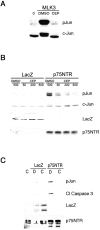Apoptosis induced by p75NTR overexpression requires Jun kinase-dependent phosphorylation of Bad
- PMID: 14673001
- PMCID: PMC6740508
- DOI: 10.1523/JNEUROSCI.23-36-11373.2003
Apoptosis induced by p75NTR overexpression requires Jun kinase-dependent phosphorylation of Bad
Abstract
The p75 neurotrophin receptor (p75NTR), a member of the tumor necrosis factor receptor superfamily, facilitates apoptosis during development and after injury to the CNS. The signaling cascades activated by p75NTR that result in apoptosis remain poorly understood. In this study, we show that overexpression of p75NTR in primary cortical neurons, in pheochromocytoma cell line (PC12) cells, and in glioma cells results in activation of Jun kinase (JNK), accumulation of cytochrome c within the cytosol, and activation of caspases 9, 6, and 3. To link p75NTR-dependent JNK activation to mitochondrial cytochrome c release, regulation of BH3-domain-only family members was examined. Transcription of BH3-domain-only family members was not induced by p75NTR, but p75NTR-dependent JNK activation resulted in phosphorylation and oligomerization of the BH3-domain-only family member Bad. Loss of function experiments using Bad dominant negatives or RNA interference demonstrated a requirement for Bad in p75NTR-induced apoptosis. Together, these studies provide the first data linking apoptosis induced by p75NTR to the phosphorylation of BH3-domain-only family members.
Figures









References
-
- Barker PA, Shooter EM ( 1994) Disruption of NGF binding to the low affinity neurotrophin receptor p75LNTR reduces NGF binding to trkA on PC12 cells. Neuron 13: 203-215. - PubMed
Publication types
MeSH terms
Substances
Grants and funding
LinkOut - more resources
Full Text Sources
Other Literature Sources
Molecular Biology Databases
Research Materials
Miscellaneous
